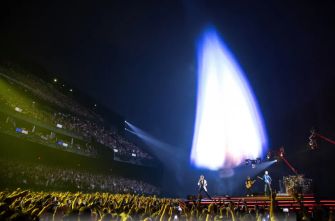In today’s economy, the price of passion for concerts has never been higher.
According to a new Billboard report, the average concert ticket in 2024 hit $136, a steep climb from just a decade ago, when fans could still catch their favorite acts for under $50. While that number might not raise eyebrows at first glance, the extremes are staggering: Fans shelled out over $20,000 for premium seats to Taylor Swift’s Eras Tour, setting a new benchmark for what people are willing to pay to experience live music.
But the issue runs deeper than a few viral headlines: across genres and venues, from dive bars to stadiums, fans are adapting to a new financial reality. Nearly 60% of Coachella 2025 attendees used Buy-Now-Pay-Later (BNPL) services to secure their passes, spreading out the cost of entry just to be part of the cultural moment. What used to be a one-night splurge is now something many fans are financing like a small loan.
And for many, it’s worth it. In an era dominated by digital detachment, live music remains one of the few visceral, in-the-moment experiences left. “People don’t want to miss out,” says a live music economist quoted in the report. “For a lot of them, concerts aren’t a luxury anymore. They’re a necessity.”
Dynamic Pricing, Digital FOMO, and the Cost of Belonging
Still, the system behind these price hikes isn’t exactly fan-friendly. At the center of the storm is Ticketmaster, a titan in the live entertainment industry that’s long been accused of monopolistic behavior and murky pricing practices. Between dynamic pricing models that mimic airline ticketing, inflated “platinum” tiers, and service fees that balloon at checkout, fans are often left feeling like the ticketing experience is a game they were never meant to win.
These algorithm-driven systems adjust prices in real time based on demand, turning every high-profile tour into a digital arms race. For younger fans and lower-income households, the results are alienating. What’s emerging is a two-tiered concert culture—one where the front row is reserved for the financially elite, while the rest are priced into the nosebleeds or out entirely.
Let’s not ignore the cultural forces adding fuel to the fire: In a world where social media plays curator to our identities, being present at the concert has become as much about content as connection. Not attending the hottest tour of the year isn’t just a personal disappointment—it’s feeling left out.
This cultural pressure to be part of the conversation can lead to deeper consequences. Some fans report anxiety, guilt, or even regret after overspending, another layer of emotional weight in a system already heavy with financial strain.
Is a New Model for Fans and Artists Possible?
Yet amidst the chaos, Indie artists and venues are pushing back with fair pricing initiatives, community-based shows, and fan-first ticketing strategies. Some are experimenting with blockchain ticketing and artist-owned platforms to cut out corporate middlemen and resellers. While these models are still in their infancy, they hint at a possible future where live music access is democratized again.
At its core, this is a story of value: what it costs, what it means, and who gets to decide. Live music is more expensive and more essential than ever. People are willing to go into debt for a few hours of joy, catharsis, and connection. But unless the industry begins to reckon with the structural issues driving these trends, the divide between who can and who can’t access these moments will only grow wider.






